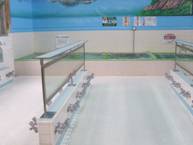|
What do you think this building in the photo is? *History After Buddhism was introduced to Japan in the sixth century, bathhouses were built in the grounds of temples. According to Buddhist teaching, bathing removes seven illnesses and brings seven kinds of good luck. For that reason, monks and followers gradually provided free bathing services to the public as a charity. Eventually, fee-based bathhouses started to operate throughout Japan, but unlike hot springs it seems most of them were steam or hot air baths as firewood and water were really hard to get. Sento became more common and important places hygienically and socially for local residents, especially in city areas in the Edo period (the 17th-mid 19th century). During World War II, many buildings and houses were destroyed, which resulted in a shortage of private baths, so after the war bathhouses were always crowded. In the post-war growth period, however, more and more people were living in new houses or apartments with their own baths. Sento have been decreasing in number since they peaked at 17,642 in 1968. As of April, 2010, there are 3,848 sento all over Japan, according to the Public Bathhouse Trade Association. *How to use sento 2.Have on hand a bath towel, a small towel, soap, shampoo, and any other
articles you usually use when taking a bath. These articles are also available
for sale at the counter. 6. Before entering the bath, you should first clean your body by rinsing with hot water, or wash your body with soap and rinse well with hot water. Soaping and rinsing must be done outside of the tub. Then enjoy the bath. Lastly, to avoid making the floor of the changing room slippery, you should wipe yourself off before entering. Please go to the 30 Onsen/Japanese Hotsprings page on the Japanese Culture website. Youfll find the instructions of ghow to take a bathh are pretty much the same. *Onsen or Sento? In recent years various new types of onsen and sento have sprung up to
meet public demand. Thanks to the advancement of drilling technology, there
is more access to natural hot springs. Therefore, even in downtown areas,
hot springs or large bathing facilities called Super Sento can be enjoyed.
They offer a wider variety of services including inside and outside baths,
saunas, jacuzzis,
massages and restaurants.
|


